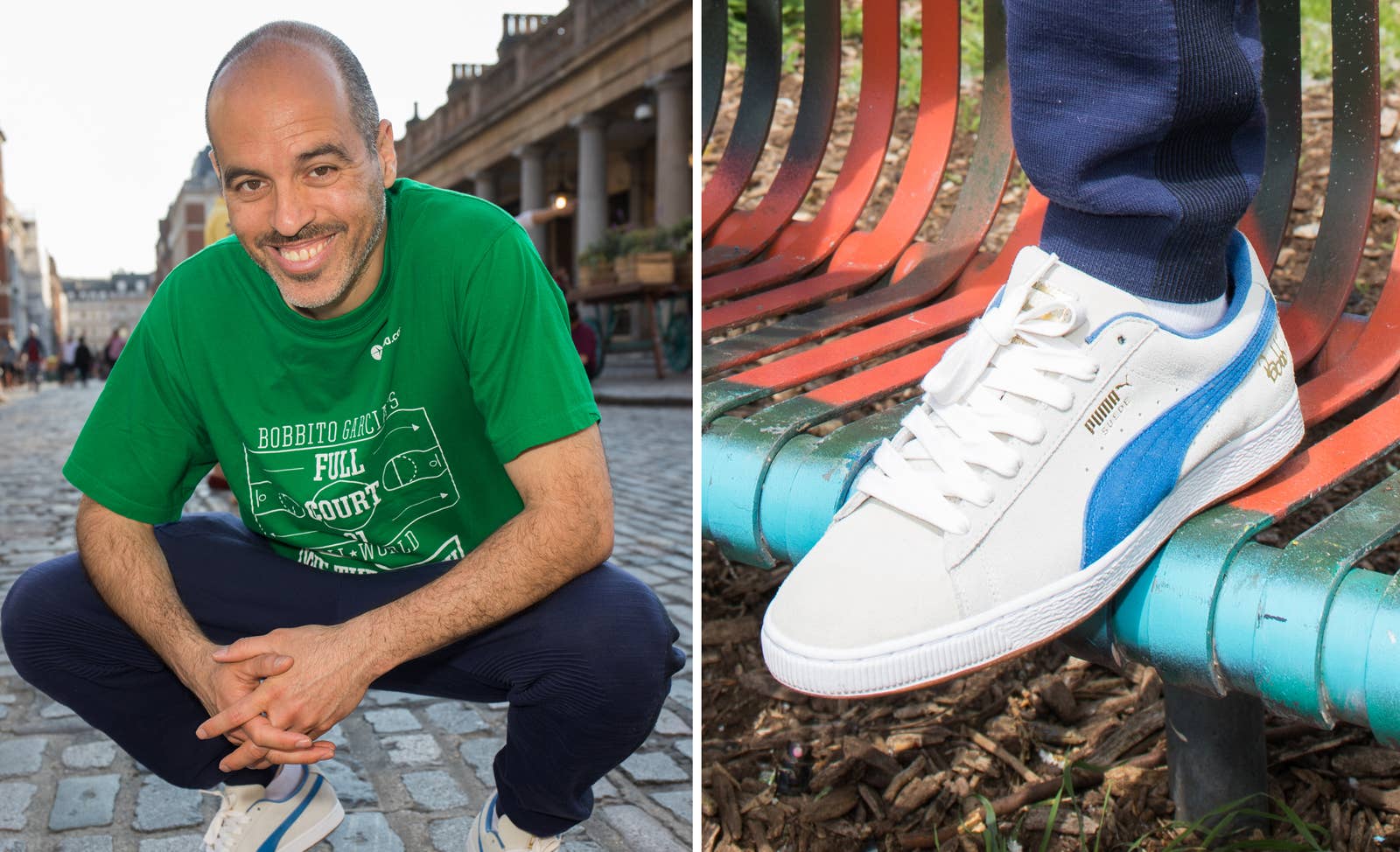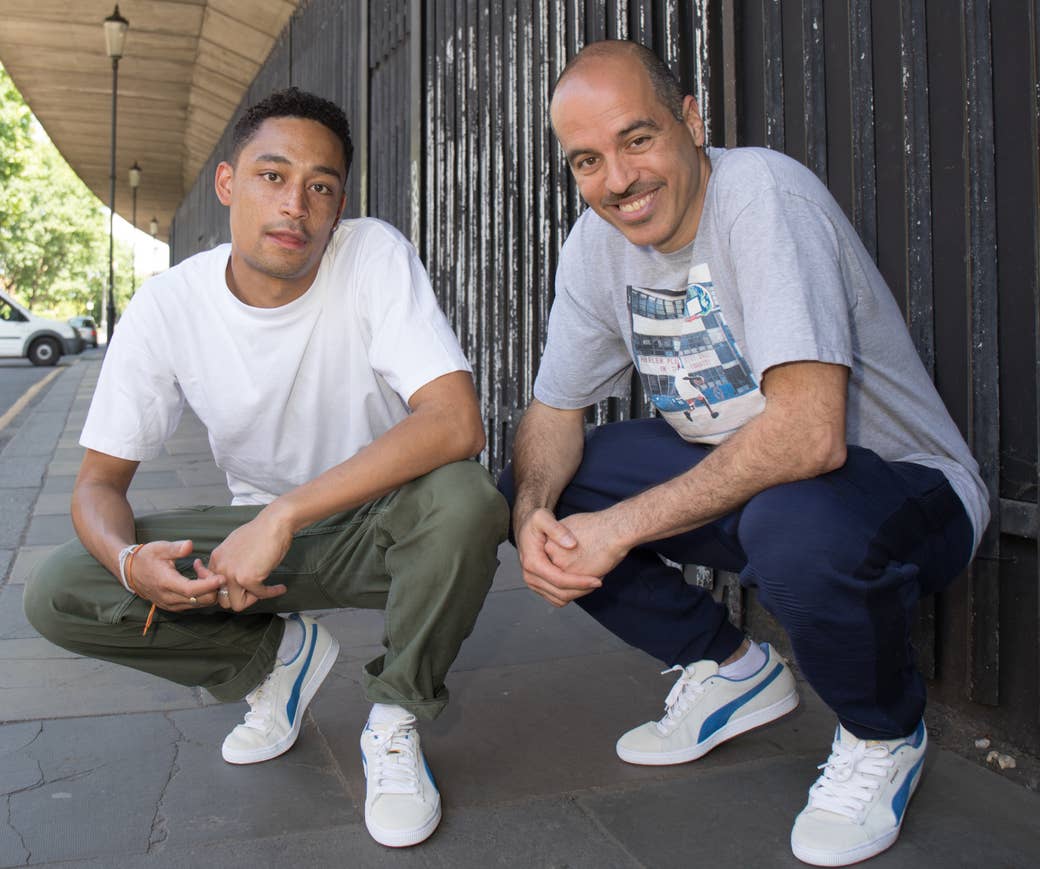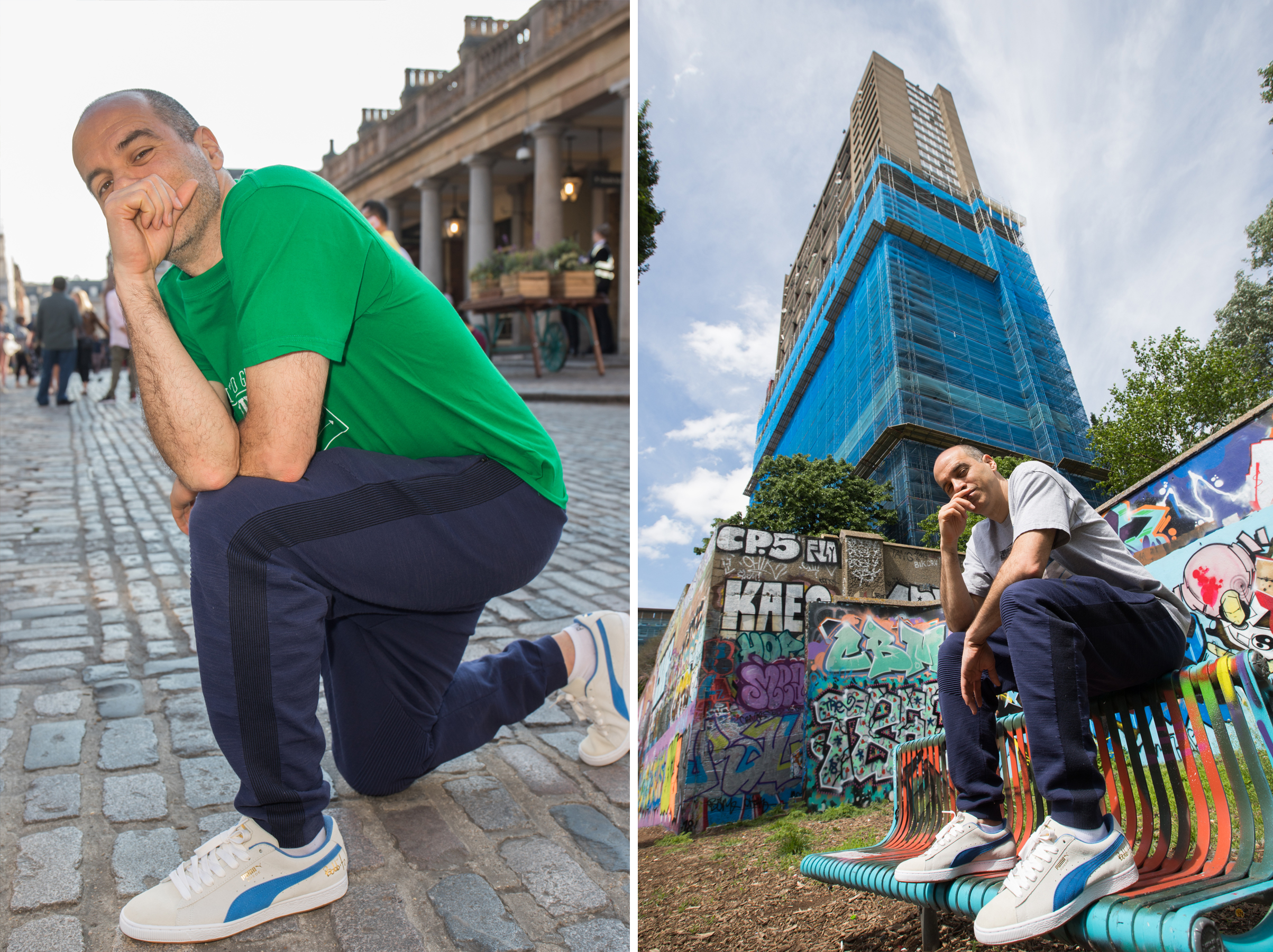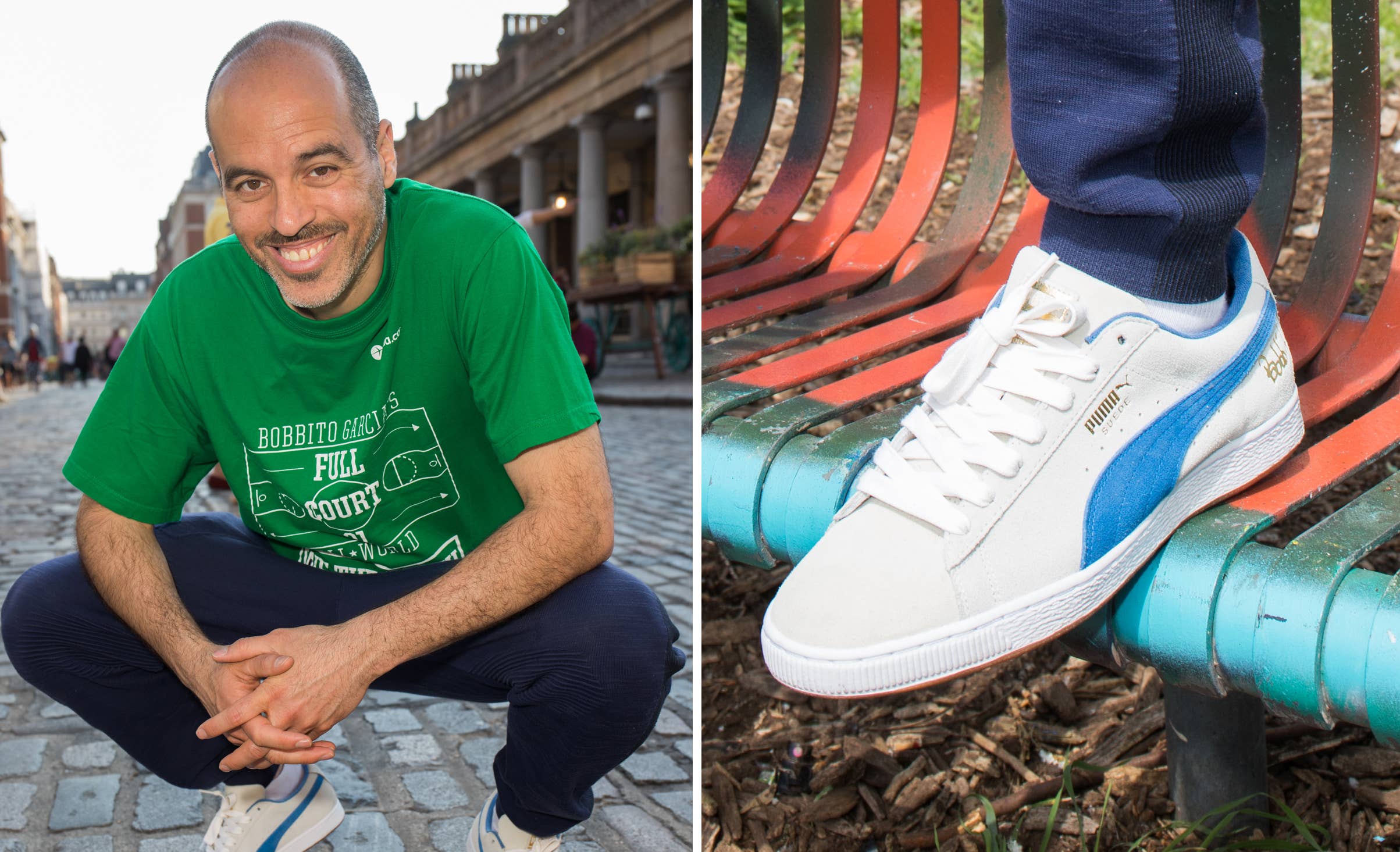
50 years ago, PUMA released its now landmark Suede shoe. After becoming an icon in sport, style and music over the last half-century, it's only right for its legacy to be recognised. As part of the Suede 50 celebration, PUMA are releasing a series of limited-edition Suedes and the latest big drop is a one-off collaboration with legendary New York hip-hop DJ and sneaker expert Bobbito Garcia a.k.a. Kool Bob Love. The special edition shoe was carefully hand-designed by the New Yorker, with his golden signature adorning the outside heel and the title of his his essential tome 'Where'd You Get Those?' on the inside.
After becoming one of hip-hop's most prominent voices with a legendary New York radio show in the 90s, Bobbito remains one of the culture's true historians. While in London to launch his latest Suede collab, Bobbito linked up with the likes of Snips, Rodney P, Jonzi D, Shortee Blitz, Kash and Loyle Carner for an upcoming film with Complex unwrapping the past, present and future of UK hip-hop. While on the set, we sat down with Garcia to discuss the evolving relationship between hip-hop and sneaker culture and the importance of that symbiosis.

Complex: Obviously, we’re here in London. How familiar are you with UK rap? Is that something you’ve explored much?
Bobbito: Yeah, I don’t know much of the current scene, because I checked out from hip-hop radio in 2002. I’m not the person to tell you who the hottest up-and-coming MC is but dating back to my first trips to the UK in the mid 90s, through my record collecting and digging I’ve always been aware, as best as possible, of what’s been going on in the UK because it’s always been quality. The scene here, the community, really cared about what we were doing in New York, digested it and then started spitting out their own form of it and I’ve always been intrigued by it. So whether it was Rodney P or Funky DL or Mud Fam or Shortee Blitz or Spin Doctor or all the graff writers I would see out here. The UK has always had style. Beyond hip-hop, when you think of hip-hop derivatives like trip-hop, broken beat, the UK house scene, neo soul, acid jazz… I was up on all that. I used to be up on Blues & Soul, Fat Lace, any publication coming out of here. Anything about hip-hop that came out of the UK.
I used to work for Def Jam from 89 to 93 so I used to send records to Tim Westwood on Capital Radio and when I started doing the radio show with Stretch we started to exchange tapes. I would send him a tape of ours, he would send us a tape of his. He sent me the Ultramagnetic live performance [in Camden Lock with Stezo and Outlaw Posse in 1990]. It’s a long history. I’m not trying to namedrop, it’s just deep. There’s too many cats to mention from out here that were really doing it. Mr. Thing? Mr. Thing is nasty, yo. I don’t want to DJ after Mr. Thing. He’s one of those shutdown DJs. There’s like a handful of cats you don’t want to go on afterwards and he’s one of them.
Where’s your head at, musically?
I don’t really listen to much rap at the minute. That said, there’s still some great records coming out.
So what are you listening to then, if not rap?
Mostly world music, jazz and soul. They’re really broad definitions, though. It might be a house record that’s really soulful. There are so many subdivisions and subgenres. And when I say ‘world’ I mean afrobeats, samba, the various rhythms of Afro-Latin music, from Afro-Cuban to Afro Boricua. I just try to keep an open mind to great music that has composition, that has some meaning, some spirituality, that has had some effort put into being made. I’m not into disposable music. I like to play records as a DJ from beginning to end. I don’t come in and out of records. One verse, one chorus and done. Sometimes I might do that if I wanna keep a certain energy. There are artists who make records that scream to be heard and you’re doing a disservice to your audience and the artist if you cheat them out of the entire record.
Right now, I’m missing incognito, r-e-e-l people. There are incredible artists coming out of the UK but I buy vinyl so I don’t even know if they’re still making music. Portishead, for example, Massive Attack, Soul II Soul, Omar. He’s incredible, he has a new album dropping soon. Any of the UK soul people. Zara McFarlane — I didn’t know she was from the UK but I love her. She had a cameo on Louie Vega’s last album and she crushed it.
How do you feel hip-hop’s relationship with footwear has changed over the years?
The relationship between hip-hop and the footwear industry has greatly changed, because all the brands that were founded in the 1900s, through the greater part of the century, were all really focused on performance. They were athletic footwear brands, they were founded as such and they cared about the athlete, they spoke to the athlete. Growing up, as a kid in the 60s, 70s and 80s, there was no voice that we had to the brand. We couldn’t say like “Please put out that sneaker in purple", and the brands had no ear to what we were doing either. All they cared about was that the track star said the spikes could be tighter or the tennis star wants more traction on the turf or the basketball player wants better cushioning on the ankles. That’s what the brands cared about. Then, come the 90s when hip-hop really exploded, like globally. I mean, hip-hop exploded in the 80s but it took a different turn in the 90s. Then, in the 2000s with all the forums and social media, now you have this really symbiotic relationship where brands not only listen, but they care. You’ll see them reissuing a certain shoe or doing a drop in a certain city, because that community spoke volumes to that brand and they realised if they wanted to be relevant and to sell, if they want to have long-term branding, they have to not just cater but pay attention. That’s a big difference.
For me, I’m not a former NBA athlete, I’m not an Olympian, I’m not a platinum-selling recording artist, why the hell would PUMA want to do a collab with me? Really. If you look at who they partnered with in the 60s and 70s, Juan Carlos raising the fist in Mexico ‘68, Walt “Clyde” Frazier in ‘72 when he was MVP of the NBA finals. They partnered with Usain Bolt recently. Major, major athletes! When you put that next to a guy like me, I’m major in sneaker culture because of my contributions. The fact that they could value that and do a collaboration that is not just a one-of-one for me to wear, but something that’s available for their followers to consume. That’s huge, man. I don’t think people really get the idea of the historical perspective of how huge that is. You look at Stash’s career and collabs, mine, Clark Kent. None of us were doing that until the 2000s. Who was getting a collab like that in the 90s? Nobody. You can’t think of anybody.

And how did your relationship with PUMA all start?
There was a dude from PUMA that hit me up in 2014 about doing a collab for the Clyde. That was a no brainer. You kidding me? The Clyde? The Clyde? So I put my imprint on that and the shoe made some noise. They don’t share sales but I do know in some stores they sold out. It got a general social media buzz and all the sneaker sites were writing about it. Then it culminated in me interviewing Clyde for a PUMA video. That was great. Clyde and me were on the broadcasting team for Madison Square Garden Network for the New York Knicks home games in 2006/7. So I knew him. Not well, but I knew him. To talk to someone about sneakers and basketball and New York, it was just so great. That was the beginning. After that I reached out to Teresa Tayzon at PUMA saying “Hey, it’s been a year since the release and people are still buzzing about the shoe… can we do another?” That was really just an innocent solicitation and they jumped on it. It turned out they had the 50th anniversary of the Suede and they brought me back to do the collab and two releases and I’m really excited about it.
How do you think the Suede’s position has changed within sneaker culture? Do you think it’s being worn in a different way by different people?
The PUMA Suede, for me, will always be a basketball shoe. It goes back to performance. I’m from the 60s so I saw it worn when people were playing in it. I can’t lose sight of that. Even if the brand has stopped making performance shoes, the Suede and the Clyde and the Basket will forever be basketball shoes. They’ve transcended that and become iconic, casual, lifestyle, fashion items. You’re not going to see a soul in the world buying the PUMA Suedes specifically to play ball. I’m wearing my PUMA Suedes right now and if someone’s shooting around I’m not going to run back to the hotel to get the high performance, I’ll just lace ‘em up and play. That’s how I am. But I wouldn’t specifically wear the Suedes to go out and play. Their performance, design, research and development has improved in the last 50 years!
In terms of a design perspective, my goal with the Clydes and with the Suedes for 2018 was to present them in a manner that would be reminiscent of the era that I grew up in. It echoes the origins of the shoe and that the narrative for people who are incredibly savvy when it comes to culture and fashion and music so that they can have a light bulb realisation that people can play ball in low cut PUMA Suedes. Low cut. People can’t fathom that now but it’s a basketball shoe. It still deserves to be called a basketball shoe. Whether you where it out of context or not, it’s a basketball shoe. That’s my job as the 51-year-old: teach the kids!

How much creative control did you have over the shoe?
PUMA, I got to give them credit. I’ve done collabs with other brands, but they’re so organised. They had this whole system I could pick from. They had x amount of laces, I could do wax laces, I could do cotton laces, I could do coloured laces. They gave me x amount of fabrics for the stripe… It was just so well presented. It was the quickest design I’ve ever done. Of course, you have to go back and forth with the drafts and see the samples and make tweaks and so on, but they made it easy. They didn’t really give me push back on anything I wanted. The gum bottoms — I love gum bottoms — and initially that was an issue for them, but they went with it.
Did you refer to your book at all? Either for inspiration or to avoid repetition?
No. I don’t know what was done in the last 31 years. I know what was done prior to 1987. I’m not a person that could tell you about the current trends or the drop last week. I don’t follow Hypebeast, High Snobiety, Nice Kicks or Sole Collector. I’m not on any of those blogs. I don’t follow any of their social media. It’s too much. It’s overwhelming. I see what’s on people’s feet. And I’m not really concerned. If someone had done the burnt orange last year I know they didn’t do it the way I did it. It doesn’t have my name on it and it doesn’t have “Where’d you get those?” on the inside, which is the catchphrase of all time. That phrase sums up my whole experience as a child in terms of being a connoisseur of sneakers.
Anything you want to add?
If you’re curious about my contributions to sneaker culture and beyond, stay tuned for my autobiographical documentary called Rock Rubber 45s. It drops this summer. Worldwide digital release July 24.
The PUMA Suede 50 x Bobbito is now avaiable at Hanon, End Clothing, Footpatrol, Urban Industry and 5 Pointz. Share your Suedes with the hashtag #ForAllTime.


